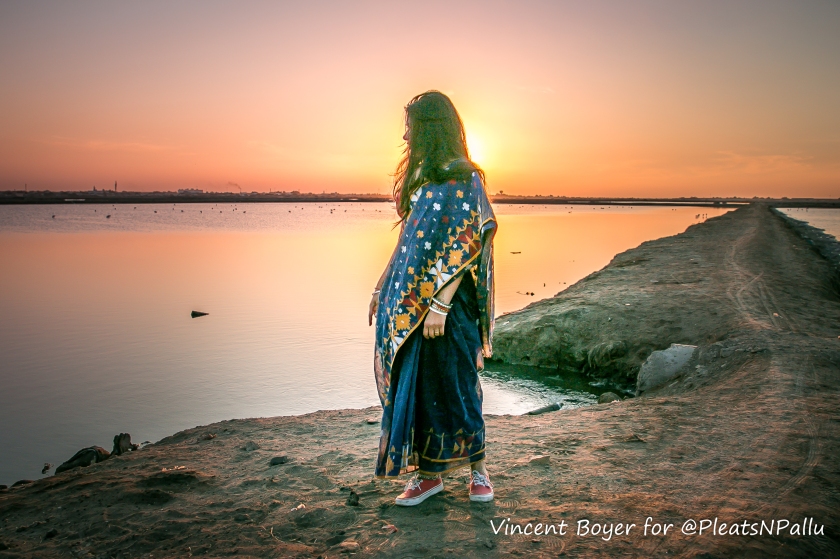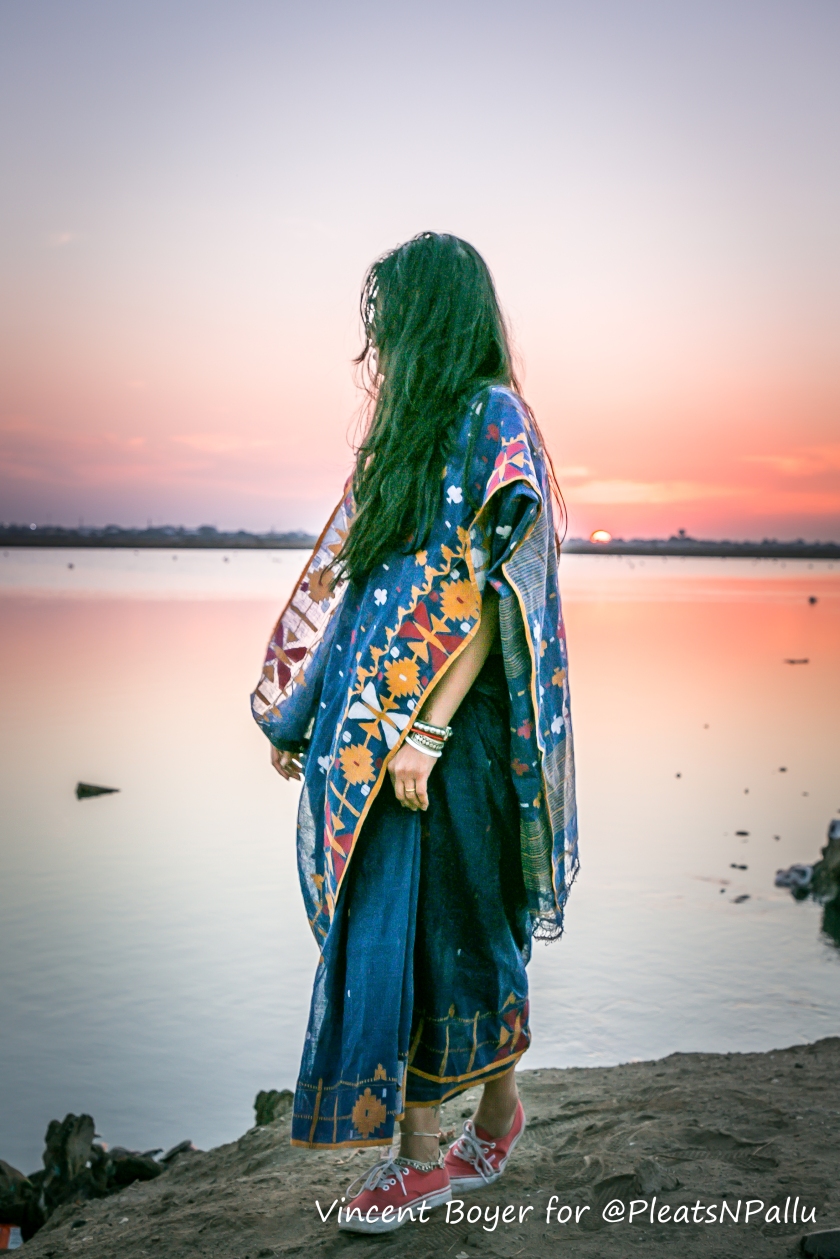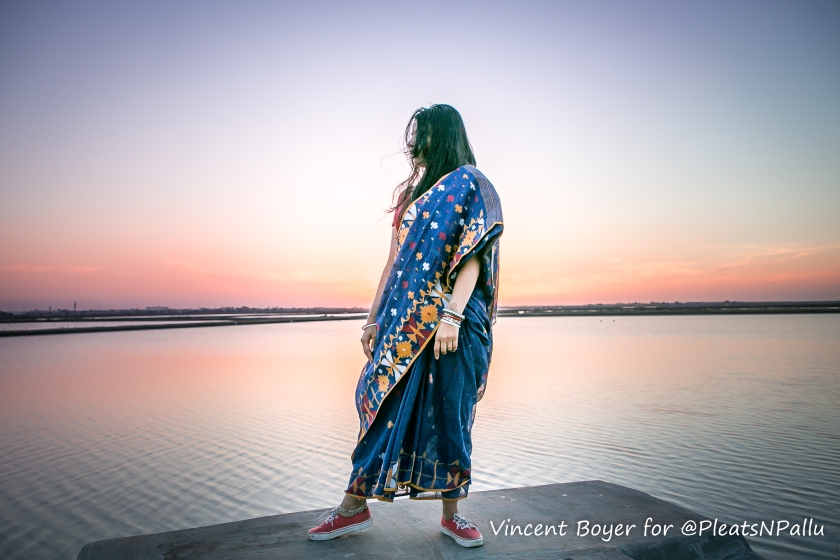A vintage indigo jamdani framed by a ridiculously stunning sunset at the salt pans by the Arabian sea which is a favourite haunt of migratory birds …



Photos: Vincent Boyer (Say hi on instagram @vincetravelbook)
I love the ornate simplicity and the unparalleled comfort of tant jamdani sarees from West Bengal.
However, every time I wear or post photos of myself in one, I get a tonne of queries on whether the piece is a real Dhakai, with many wanting to know where to source authentic jamdanis and how to tell if a particular fabric is handwoven or machine made.
Honestly, I have just always been able to tell in photos as well as in person if a length of jamdani fabric is handwoven or not, its just something one picks up in a home where handcrafted textiles are appreciated.
It irks me to no end that these days many self-procliamed experts wear power loom replicas and give lectures on wearing handloom fabrics! Another thing that annoys me even more are sellers online selling tant jamdanis as Dhakai muslin jamdani.
Firstly, these days muslin or (mulmul in Hindi) means any lightweight, gauzy, mostly inexpensive, machine-milled cotton cloth, the word has lost all connection to the handwoven fabric that once came exclusively from Bengal.
The famed muslin of yore was a finely handspun and handwoven light cotton fabric that was woven in a specific area with locally grown crop by Bengali weavers called tantees or karigars.
Secondly, jamdani is an inlay weaving technique not a weave that is synonymous to a specific place. A supplementary weft is labouriosly added during weaving, where motifs are created by an extra weft, in addition to the standard weft that holds the warp threads together.
The standard weft creates a fine, sheer fabric while the supplementary weft, added separately by hand using fine bamboo sticks and individual spools of thicker threads adds the decorative motifs and patterns.
Jamdani on fine muslin has been synonymous with Bengal for many centuries, historically they were woven from hand spun cotton threads on a simple pitloom with no attachments of any kind, its distinguishing features being the motifs and the serrated edges or daant that give form to a large number of motifs.
Traditionally, the base fabric used to be white, grey or beige with natural dyed threads creating the supplementary weft motifs, however the delicate muslin mentioned multiple times in historical texts was a pre-colonial textile made from a cotton variety that grew only along the banks of the Meghna river near Dhaka and to its south.
Cotton harvested from Gossypium arboreum var. neglecta, known locally in Bangladesh as phuti karpas, was spun to create threads that maintained tensile strength at counts higher than any other cotton species. But phuti karpas defied transplanting to other locations, and British colonial policy eliminated it completely.
The gossamer soft, light as wind fine muslin of Dhaka hasn’t been produced for close to 400 years! Anything being sold as Dhakai muslin today is either the normal tant (cotton) or soft high count cotton or handspun as well handwoven delicate fabric or some other mix of cotton, silk and even nylon.
There are a lot of so called new-age muslin fabric out there but none of them are the original Dhakai muslin. It is for all intents and purposes extinct! Not all hope is lost though, for the past couple of years experts at the Institute of Biological Sciences, Rajshahi University (RU) have been working on reviving the famous muslin but their research is still ongoing.
Researchers working on the project have stated they will replicate the old method of weaving muslin by hand and try and use a machine to achieve the same result.
Many Hindu tantees migrated to India during and post the partition in 1947 and set up weaving units in West Bengal.
Delicate yet far less fine than the original authentic Dhakai muslin, jamdani sarees are currently hand woven in West Bengal, Bangladesh and Andhra Pradesh. I personally prefer the tant or khadi jamdanis from West Bengal over anything that comes from Bangladesh as I like hardy sarees that can be washed at home.
Currently the regional variations in jamdani include:
Dhakai Jamdani, made in and around the capital of Bangladesh.
Tangail Jamdani, woven in the Tangail district of Bangladesh.
Shantipur Jamdani, handcrafted in Shantipur, West Bengal and it is said that these sarees are similar to the Tangail jamdanis.
Dhonekali Jamdani with its origin in Dhonekali, West Bengal, these jamdani sarees are said to have a tighter weave compared to the Tangail and Shantipur varieties.
There are no written records of the various jamdani motifs and design types that are particular to Bengal but weavers colloquially know them as: the corolla butti, dhaner sheesh, bansh phool, pura phool, basher pa, golap pata, dola kata, chand, tara buti, dabutar khop, jalar naksha, hazar buti, panna hazar, kalka, butidar, duria charkhona, phulwar, naksha, belwari, nayan bahar, toradar, hazar tara mayuri, ichadar and more.
These motifs are repeated with extraordinary accuracy and remarkable precision all over jamdani sarees. Various combinations of designs are then known by different names, for eg: when the motifs are spread diagonally across the fabric it is called the tercha.
Most weaving artisans don’t even need the motifs sketched or outlined on the fabric, just a basic guide drawn on a translucent graph paper and placed underneath the warp at the beginning of the process suffices.
Differentiating between a true blue handloom jamdani and its various replicas, power loom or otherwise is quite easy.
Since the jamdani weaving is time-consuming as well as labour intensive process, sometimes even handloom weavers adopt short-cuts like weaving jamdani look-alike motifs on jacquard looms.
Another common dupe flooding the market is what they call cutwork jamdani, in which the extra weft threads are cut manually therefore they seem to call these handcrafted??!!
In these kinds of fabrics the looping of thread is made to run from selvedge to selvedge, letting it hang loose between two motifs and the extra-thread is then cut manually, making it a jamdani lookalike for the untrained eye. This is half as laborious as the authentic jamdani because picking and counting of the warp isn’t required at every motif.
A true blue jamdani is made from cotton, the motifs have sharp edges and on the reverse you can see the extra weft threads are never loose and always loop into the parallel lines of thread that create the design. Basically the front and the back are almost identical!
Previous blog posts featuring vintage jamdani sarees can be accessed here and here.
One thought on “Jamdani sarees: The good, bad and the fakes”